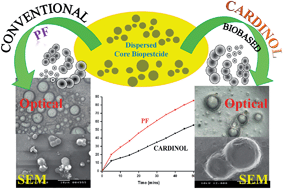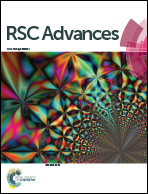Renewable resource-based polymeric microencapsulation of natural pesticide and its release study: an alternative green approach†
Abstract
Recently, the use of renewable sources in synthesizing polymers has been remarkably increased due to numerous reasons, such as finite as well as unreliable petroleum sources and increasing environmental awareness. Considering the need of the day, we are reporting the preparation of polymeric microcapsules based on cardanol as a renewable source by an in situ polymerization technique to encapsulate the biobased core. Comparative study for successful encapsulation of karanja oil by cardanol formaldehyde and conventional phenol formaldehyde-based microcapsules is made. The success of polymerization is characterized by structure and thermal analysis using FTIR and TGA, respectively. Distinctive surface morphologies of the prepared microcapsules are examined by SEM, which confirmed formation of wrinkle-free and globular-shaped microcapsules. The size of prepared microcapsules is determined by a particle-size analyzer. The amount of encapsulated core material released is estimated quantitatively by solvent extraction, and gravimetric and UV spectrophotometric methods. Thus, the current research is oriented towards the exploration of biobased, renewable shell material for the microencapsulation of biobased cores for the structural design of a new generation of pesticide formulations. Therefore, the most recent advancements include an interdisciplinary combination of biobased polymers and agrochemicals, which is a significant requirement for attaining a cleaner global environment.


 Please wait while we load your content...
Please wait while we load your content...